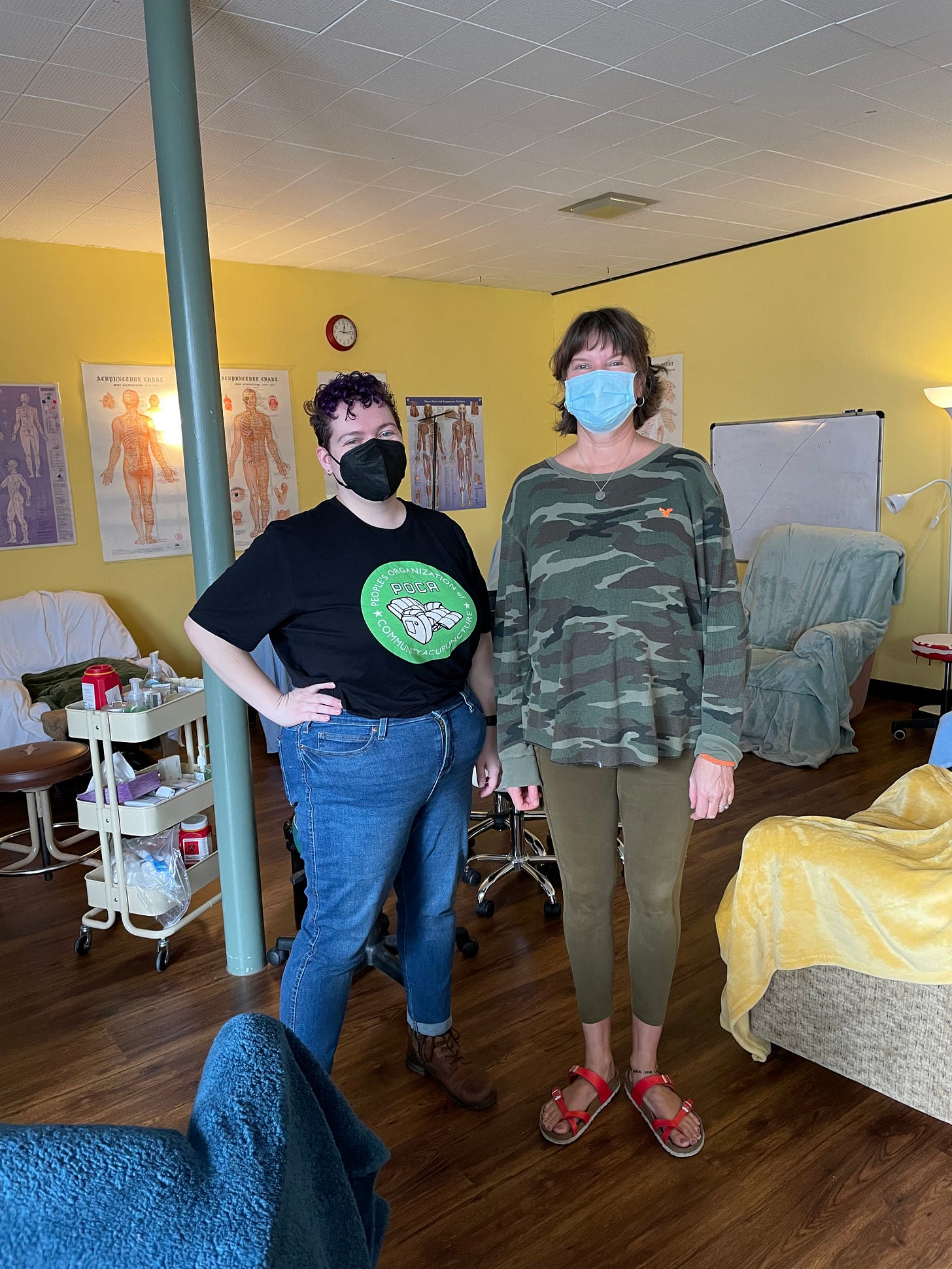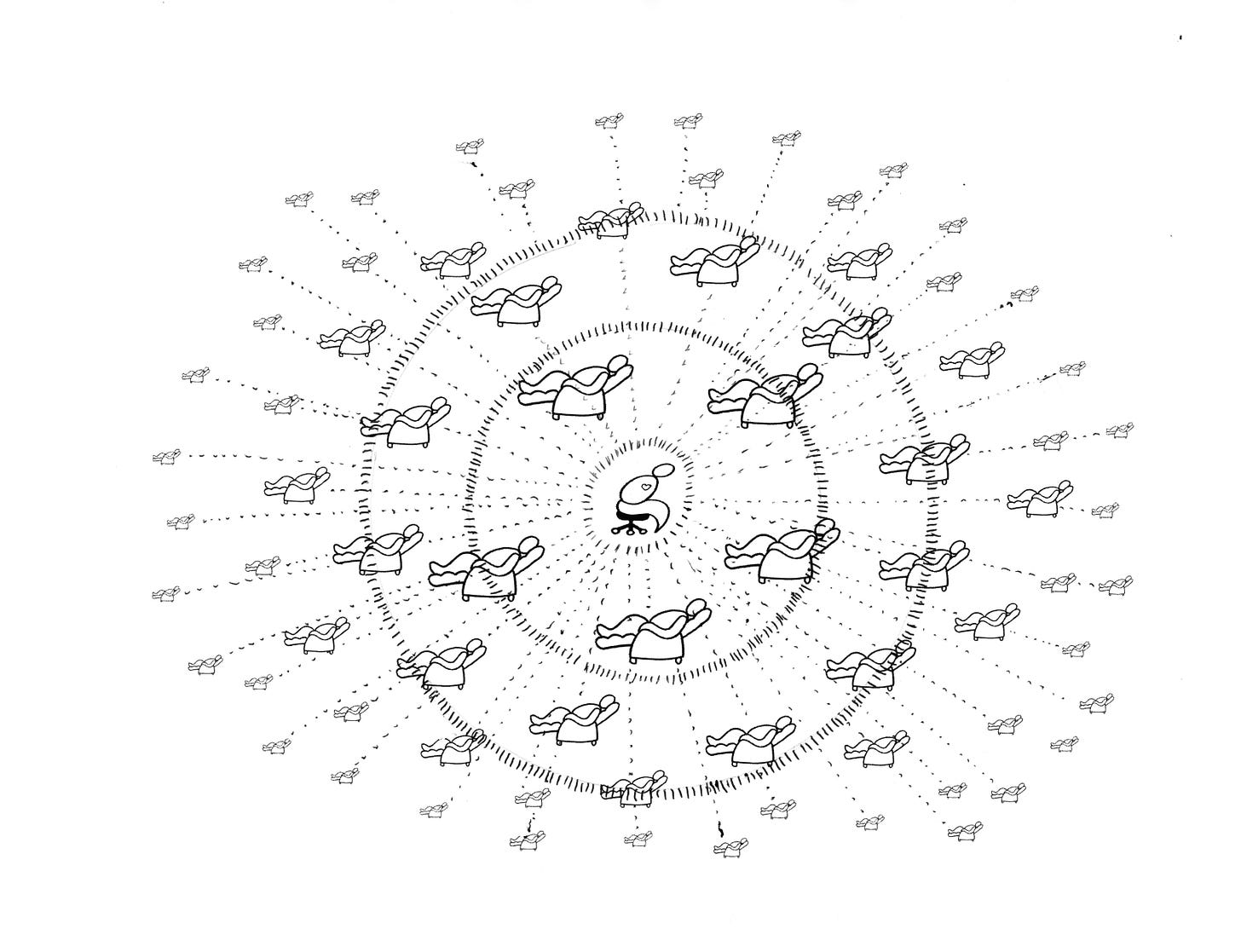
Something I’ve learned about small business is that it’s just as important to pay attention to the things that go well as the things that don’t, to analyze and unpack good things in detail — not just sigh with relief and move on to the next demand. Taking time to affirm what’s already working is a way of guiding ourselves towards MORE things that work! We recently got an opportunity to do that with a pop-up clinic.
This is N., third-year POCA Tech student who ran the event and A., second-year POCA Tech student who assisted, in our classroom treatment space where it happened, two weeks ago:
We had ten guests from Northeast Village PDX, one of our building partners in the Rose City Community Collective. Many of them were trying community acupuncture for the first time. In the space of an hour, they all filled out their intake forms, listened to a brief introductory presentation from N., and received treatments.
I was there as a supervisor to make it legal for N. to needle people, but I didn’t want to be underfoot so I hung out in an adjoining room. The layout of our space in the Collective is that our classroom treatment area is next to our library, which is next to a little kitchen, and on the other side of the kitchen is the chapel, where I was. There were two open doors between me and the pop-up so all I could hear was a low murmur of voices, then bits of N.’s speech, and then the usual rustle as people settled into their recliners. It was like a background soundtrack as I tapped away on my laptop, answering emails. About 45 minutes in, though, the soundtrack stopped. I looked up from my laptop because a wave of stillness was rolling out from the treatment area, through the open doors and into the chapel, lapping at my feet. I didn’t want to keep working, I wanted to sink into it and rest, along with everybody else in the pop-up.
What was going on? N. was being a star at holding space, that’s what. And so community acupuncture was doing what it does best.
It went on like that for twenty peaceful minutes or so, until N. and A. got people up so we could all get on with our day. Afterwards we sat down together and took notes on what made the pop-up so successful. Here’s an edited version of N.’s comments:
“Pop-up clinics are an important opportunity for students to experience what it’s like to create a structure, an energetic container for acupuncture, as opposed to just walking into a container that was pre-made for us.”
“A pop-up is really a student-driven environment. It’s a concentrated moment of being in that nucleus role. It’s vital to hold space and you can feel that urgency. In a pop-up, it’s all on you.
I’ve seen other students prepare for pop-ups and I’ve seen them work on the presentation part of it but not prepare for it as a punking event.*
I’ve seen people not think through the treatment part of it, which is really more important than the presentation part. The goal of a pop-up clinic is to give people an experience of community acupuncture, not just a lecture about it.
You need a strategy for treating the room.
And of course the paradox is that you also have to be ready to let that strategy go if conditions require it. So you have to both really think through what you’re going to do in a pop-up, but also, hold it lightly.
I visualized how this pop-up would go ahead of time. From the emails with the Northeast Village folks, I knew to expect about ten people, so I spent some time thinking about, this is what ten treatments in an hour means to me and this is what I need to do it well.
I made some decisions before I got here, including:
I would use only one packet of needles per person (for many different reasons). When I knew for sure we had ten people who wanted to be treated, I counted out ten packets of needles and put them in my pocket so they were ready to go before I rolled up to my first patient. I wanted to spend as little time at the needle station as possible, ideally only going there for hand sanitizer in between patients.
I would use Extraordinary Vessels as a clinical approach for everybody (that’s what I’m working on in clinic anyway, and this was a perfect opportunity to see how the same approach landed with ten different patients).
I would focus on my body language. Because I knew I couldn’t talk much to each patient, I would make sure my body language conveyed that I was fully present with them in the time that I had. Each treatment should feel like: this is your moment, I am holding space for YOU.
But also:
I would prioritize the rhythm of the clinic. You have to be prepared to NOT give everything at every chair, because you might need what you’ve got in reserve. For example, there might be one patient who needs more attention and responsiveness so you have to have a little extra time and energy stashed away to meet that need, just in case. And today that happened — we had a patient who needed more attention and I was able to give it because I had been careful with my rhythm. It was very helpful to have Annie taking care of blanketing people, that also allowed me to keep moving.
For a pop-up to work, you have to keep everybody focused. You can’t make people wait too long for you to get to them. You have to make sure you don’t lose the room, that it doesn’t fracture into a bunch of distracted/impatient/irritated people. Which means you have to put some thought ahead of time into what or who might derail that focus, so how are you going to protect the room from that? What’s your strategy?
And if things do go off the rails, what you can control is yourself and your energy. That’s all. Accepting that is a big part of holding space. You’re choosing to be calm and confident no matter what — that calm is the space you’re offering to your patients.
At the beginning of the pop-up, when people were arriving, it did feel a little like herding cats, trying to get everyone’s paperwork sorted and get people settled in chairs. Because people were new to community acupuncture, and they weren’t walking into a bricks and mortar clinic where they could look around and get cues from other people receiving treatments, they didn’t really know what to do. It definitely had the potential to be chaotic. I’m grateful that it came together and in the end, everything smoothed out and ended on such a peaceful note.
I wholeheartedly recommend pop-ups as an exercise in learning to hold space.”
I feel like N.’s reflections are great advice for small business in general: be aware of your limits, spend time planning how you’re going to navigate within them, get very clear in yourself about what you have to offer and how you’re going to offer it — and use your imagination! Visualize how you want your work to go — and then unpack it afterwards. Thank you N., A., and our guests from Northeast Village PDX, for a rich learning experience. I’m completely sold on pop-ups as a teaching tool.
* Community acupuncturists often call ourselves acupunks or just punks, and what we do when we’re at work is punking. POCA Tech students are fondly known as punklings.




